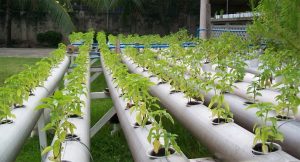
Can we have companies like Zespri or Chiquita in India?
Compliance to FSMA Produce Safety Rule can Enhance Fruit and Vegetable Exports to USA

Technology & Market trends in Horticulture and Post-harvest opportunities
Market Trends in Horticulture/Vegetables indicate that crop concepts have changed from subsistence to self-sufficiency and are now taking a stride on superfood concepts. The driving force being the food trends and health needs. Several studies

indicate predictions for the top food trends that will shape the fresh produce market.
A focus on health and longevity: Consumers increasingly see a correlation between what they eat, how they feel, and their health needs. Products with specific health components such as broccoli, kale, and several leafy assortments have become more popular, and named “superfoods.” The marketing for these niche products is growing, provoking a sales boom.
Convenience/comfort foods: Though the comfort foods are uptrending, ‘better for you’ foods are selling well. Healthy snacking is on the rise, with “grabbing and going” becoming the norm. Additionally, it is expected that the plant-based diet movement will keep growing. Meat substitution products are expected to reach a USD 2.5 billion value by 2023.
The popularity of fresh and natural: Plant-to-plate concept is a new trend. Urban gardening is scaling up as the fascination for fresh and natural is growing.
Retail success determined by quality: According to the 2019 Fruit Logistica trend report, consumers are selecting the place to buy their groceries based on the quality of the store’s fresh food. The survey also showed evidence that customers satisfied with the store’s fresh food quality would visit 7% more frequently than those who are not. Additionally, consumers are willing to pay more for higher-quality fresh produce and their average basket will be 24% larger. This demonstrated the increased importance of fresh fruit and vegetables for the profitability of food retail business, over space expansion and promotion share, for driving sales.
Success of digital platforms: The pandemic has shown the immense value of digital tools and agriculture.  The fact that systematic application of digital tools can support sustainable production & timely supply, especially when food production and supply involves millions of smallholder farmers, has been proven beyond doubt. Indian agricultural ecosystem has undoubtedly changed a lot since agritech startups started center stage working on solutions that focus on maximizing productivity, increasing supply chain efficiency, and improving market linkages. B2B platforms are emerging as an essential disruptive practice in the agriculture industry, focusing on supply chain efficiency
The fact that systematic application of digital tools can support sustainable production & timely supply, especially when food production and supply involves millions of smallholder farmers, has been proven beyond doubt. Indian agricultural ecosystem has undoubtedly changed a lot since agritech startups started center stage working on solutions that focus on maximizing productivity, increasing supply chain efficiency, and improving market linkages. B2B platforms are emerging as an essential disruptive practice in the agriculture industry, focusing on supply chain efficiency
Sustainability: According to a report by the Retail Industry Leaders Association (RILA), 93% of global consumers expect the brands they use to support social and environmental issues.
Innovative disruptions: As it is said “Necessity is the mother of invention”, the recent pandemic has pushed some farmers to come up with innovative use of produce during lockdown due to pandemic.
Post-Harvest Technology (PHT): PHT is an integral part of the food chain. It starts from harvesting, grading, cleaning, packing, shipping, till it reaches the plate of the intended consumer. I would say, this is an area of tremendous potential and there are ample opportunities and scope for research. Integration of agritech can enhance the success of PHT.
Agricultural Technology (AgTech): The fourth revolution has reshaped the context of agricultural technology (AgriTech) with applications of artificial intelligence (AI) and a strong focus on data-driven analytical techniques.
Optimal solutions for sustainability could be viewed through the applications of smart and precision techniques in agrarian operations (for the problems associated with the arable land and environmental efficiency).
Precision farming: After the Green and Gene revolution, the world is all set for the Brown revolution. In the US the work has already started, where soil samples are being mapped, balanced nutrient, irrigation regime recommended. This kind of precision
agriculture has led to a yield increase to 11 Tons/ha (India-2.5t/ha).
New milestones
- Purchasing quality inputs like seeds, fertilizers can be enabled online. (mostly seeds)
- Mobile apps like EWS Plant doctor online, Plantix are providing solutions for crop agronomy and disease and pest management.
Nano Urea solution by IFFCO:
IFFCO has introduced the world’s first nano urea solution to farmers around the world. It is also planning a large-scale national campaign exercise to demonstrate and train farmers in its usage and application. The solution is developed through a proprietary technology developed at Kalol’s Nano Biotechnology Research Center.
Read More
Paradeep Phosphates acquires Zuarinagar plant of Zuari Agro:
Competition Commission of India (CCI) approved Paradeep Phosphates Limited’s acquisition of Zuarinagar, Goa plant of ZACL. With this acquisition PPL will get into the business of developing and manufacturing urea and non-urea fertiliser products presently being carried out by ZACL at the Zuarinagar plant.
Read More
Fly-Cocobot, to ease the task of coconut harvesting:
Simple, innovative and cost-effective drone-based product Fly-Cocobot has been designed by ICAR- Central Coastal Agricultural Research Institute and the Goa University. This state-of-the-art technology will change the landscape of coastal agriculture practices. The main advantage of the product is that it is a gender-neutral device with an operational efficiency of reaping 12-15 palms/hour. Also, the availability of this device will encourage various farmers to indulge in the combination plantation system of the two crops
Read More
MoU in place for demand Based tele agriculture advisories:
Indian Council of Agricultural Research (ICAR), Ministry of Agriculture and Farmers Welfare and Digital India Corporation (DIC), Ministry of Electronics & Information Technology have signed a MoU with an objective to integrate the existing interactive Information Dissemination System (IIDS) platform with the proposed KisanSarathi program of ICAR. IIDS gives an option to farmers to receive individual needs-based information for the services they have subscribed.
Read More
New rice varieties released by IIRR:
Hyderabad-based Indian Institute of Rice Research (ICAR-IIRR) has recently released four new rice varieties of rice. These four new rice varieties that are resistant to bacterial blight to a major extent. DRR Dhan 53 with four major bacterial resistant genes has been released for cultivation in irrigated and bacterial blight endemic areas of Andhra Pradesh, Telangana, Chhattisgarh, Karnataka, Tamil Nadu, Jharkhand, Odisha, Bihar, Gujarat and Maharashtra.
Read More
Onion genome elucidated by researchers at Wageningen:
Researchers from Wageningen University have unraveled the onion genome. This will enable the plant breeders to speed up and develop new onion varieties that are resistant to conditions such as drought, and meet the world’s growing demand for onions. They successfully sequenced a large proportion with the help of the latest DNA sequencing technologies. The University has collaborated with three companies on sequencing the onion's DNA
Read More
Black pepper micronutrient foliar formulation gets patent:
Crop specific designer micronutrient foliar formulations for major spices (black pepper, ginger, turmeric, and cardamom) by ICAR-IISR. They have received the patent for black pepper micronutrient foliar formulation. It has been licensed to seven entrepreneurs on non-exclusive basis for commercial production. The application of black pepper micronutrient mixture enhances the quality of the produce & contribute to to health of vines through balanced nutrition.
Read More
India set to become self-reliant in saffron production with onset of commercial cultivation in Himachal Pradesh:
Council of Scientific and Industrial Research (CSIR) & Institute of Himalayan Bioresource Technology (IHBT) with intense research have overcome key bottleneck in saffron production related to production of disease-free good quality flowering size saffron corms. With this, Himachal Pradesh not only aim to surpass the Jammu & Kashmir production but also help in making India self-reliant in saffron production.
Read More
Click here to Download the PDF version
Authors





Connect with Authors at: E-mail agribusiness@sathguru.com
 Grow Beyond
Grow Beyond 





